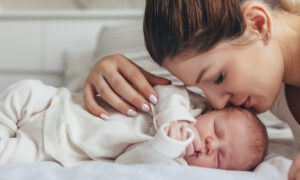As your little one grows, so do the challenges and milestones of parenting. One significant transition many parents face is moving their child from a crib to a bed. It’s a big step that requires thoughtful consideration and planning.
If you’re a parent in this situation and looking for tips, then this can help you. This guide will give you practical tips and insights to make this transition as smooth as possible.
Signs of Readiness
Keep an eye out for these signs – they’re clues that your toddler is ready for a different sleep setup.
Understanding Physical Readiness
One of the primary signs that your little one might be ready for the move is if they keep escaping the crib. If you find your toddler getting good at climbing out, the crib is no longer the safest sleep environment. Additionally, consider your child’s increased height and weight, as these physical changes can influence moving to a big-kid bed.
Cognitive and Emotional Readiness
Cognitive and emotional readiness are just as important, so If your child starts showing interest in beds, it might be a good time to consider the transition. Also, if your child can follow simple directions, that means they are becoming more independent, which makes the move to a bed a normal next step.
Planning the Transition
Changing from a crib to a big-kid bed takes some planning. Here’s the lowdown on when and how to make this change without causing too much bedtime fuss.
Selecting the Right Time
Timing is key when transitioning from crib to bed. Consider factors such as your child’s age and family dynamics. While there’s no one-size-fits-all approach, it’s generally recommended to move between 18 months and 3 years. Look for a time when there are no major disruptions or stressors in your child’s life, ensuring a smoother transition.
Involving Your Child
Making your child actively participate in the process can foster a sense of ownership and excitement. Allow them to choose bedding for their new bed or pick out a special stuffed animal or pillow. By involving your child in these decisions, you’re making the transition a positive and empowering experience.
Choosing the Right Bed
Now that you’re all set with when and how to transition your kid, it’s time to pick their bed.
Options for Transition Beds
Toddler beds are specially designed for this transitional phase, often featuring low-to-the-ground designs and safety rails. Alternatively, you can opt for a twin bed with safety rails to accommodate your growing child.
Considering Safety Features
Regardless of the bed type you choose, safety is paramount. Ensure the bed is sturdy and well-constructed to prevent accidents. A low height makes it easy for your child to climb in and out safely. Safety rails are crucial to prevent accidental falls during the night.
Preparing the Bedroom
Now that the bed’s picked, it’s time to set the stage for sweet dreams in the new sleep spot.
Creating a Familiar Sleep Environment
To ease the transition, maintain a sense of familiarity in the new sleep environment. Place familiar items from the crib, such as a beloved blanket or stuffed animal, in the new bed. Consistency is key, so stick to the bedtime routine your child is accustomed to.
Safety Measures
Childproofing the bedroom is crucial for a safe sleep space. Remove potential hazards, secure furniture to the wall, and ensure that the room is free from any objects that could harm your exploring toddler.
Overcoming Challenges
Moving up to a big kid bed has its challenges. Here are some tips on how to deal with those problems at bedtime.
Dealing with Sleep Regression
It’s not uncommon for children to experience sleep regression during this transition. Changes in routine and environment can disrupt sleep patterns. To manage this, be patient and consistent with bedtime routines. Reassure your child with comforting words and actions, and the sleep regression phase should gradually subside.
Addressing Separation Anxiety
The move to a big-kid bed can sometimes trigger separation anxiety. To ease this, consider a gradual transition. Start by spending a few nights sitting beside the bed until your child feels comfortable. Introduce comfort items, such as a nightlight or a special bedtime story, to provide reassurance.
Dealing with Nighttime Fears
It’s not uncommon for children to develop nighttime fears during this transition. A nightlight can provide a comforting glow, helping to dispel any fears of the dark. Establish comforting bedtime rituals, such as reading a favorite book, to create a sense of security.
Seeking Professional Advice
If you encounter persistent challenges or concerns, don’t hesitate to seek advice from a pediatrician or a sleep specialist. They can offer guidance tailored to your child’s specific needs, ensuring a successful transition.
Cheers to Dreamy Nights and Growth!
As you help your little one transition from crib to bed, remember that every child and parenting are different too. While this guide offers excellent insights and practical advice, your parental instincts are invaluable. Trust your intuition, enjoy surprises, and enjoy watching your child grow.
When selecting the right bed, be sure to check out B2C Furniture’s kids beds and their various options.



































